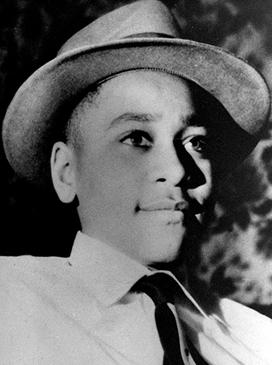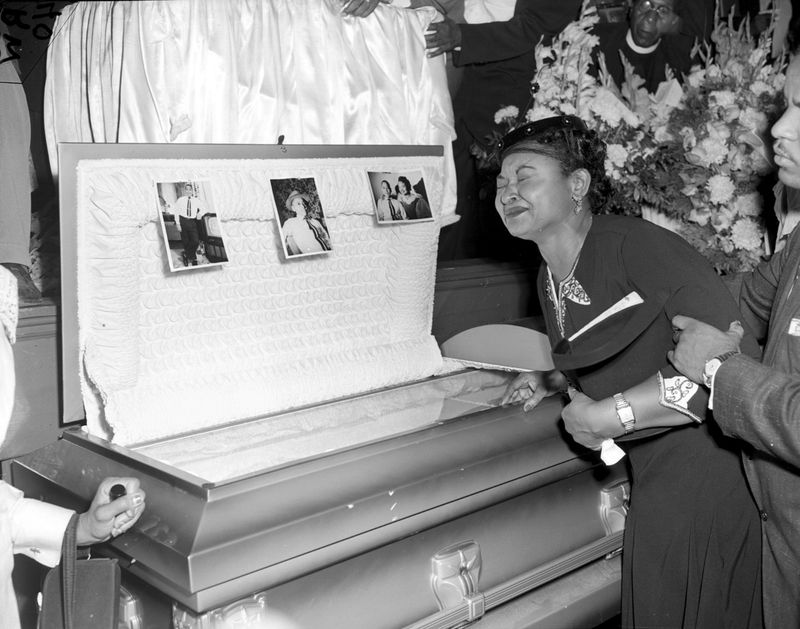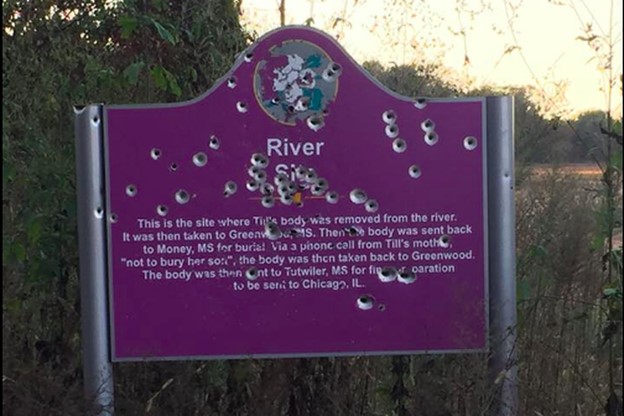In August 1955, 14-year-old Emmett Louis Till traveled from Chicago to visit his uncle and relatives three miles outside of Money, Mississippi. During his visit, Emmett Till went to the Bryant store with his cousins and may have whistled at Carolyn Bryant (accounts vary on what actually happened at the store run by Carolyn Bryant and her husband, Roy Bryant). A few days later, Emmett Till was kidnapped in the middle of the night at his great-uncle Moses Wright’s home, and then tortured and murdered by Roy Bryant and brother-in-law, J.W. Milam, who dumped his body in the Tallahatchie River after having tied a cotton gin fan around his neck. His badly battered and ravaged corpse was retrieved days later from the water.

When Till’s body was brought back to Chicago at the beginning of September 1955, Mamie Till, Emmett’s mother, “focused much of black Chicago on her son’s murder and the movement it could help unleash.” She wanted an open casket for her son and insisted that her son’s body – which remained in a truly dreadful state – shouldn’t be retouched to ensure that the world would witness the brutality of his treatment. At the funeral home, photographer Ernest Withers took a close-up picture of Emmett’s face that was published in Jet magazine on September 15 and became perhaps the photograph with the greatest effect in American Black circles historically – it “was passed around at barbershops, beauty parlors, college campuses, and black churches, reaching millions of people.”
 Mamie Till Mobley at son's funeral September 6,1955 image credit AP/Chicago Sun Times
Mamie Till Mobley at son's funeral September 6,1955 image credit AP/Chicago Sun Times
The Mississippi Civil Rights Project’s website explains the circumstances of the legal procedures that took place after of the discovery of Till’s body in the Tallahatchie River: “The Grand Jury meeting in Sumner, Mississippi, indicted Roy Bryant and J.W. Milam for the crime of murder. These two men were then tried on this charge and were acquitted by an all-white, all-male jury after a deliberation of just over an hour. Within three months of their acquittal the two men confessed to the murder. Before the trial began, Till’s mother had sought assistance from federal officials, under the terms of the so-called "Lindbergh Law," which made kidnapping a federal crime, but received no aid. Only a renewed request in December 2002 from Till’s mother, supported by Mississippi District Attorney Joyce Chiles and the Emmett Till Justice Campaign, yielded a new investigation.”
Most recently, on December 6, 2021, the United States Justice department closed the latest investigation on the case, which was reopened after the publication of historian Timothy B. Tyson’s book The Blood of Emmett Till. In this book, the author asserts that Carolyn Bryant recanted her testimony in a 2008 interview; Tyson claims that Bryant told him that the parts of the story she had told at the trial of her encounter with Emmett Till at the store, namely that “Till had grabbed her around the waist and uttered obscenities,” were not true. The Justice Department closed the investigation because Bryant (now Bryant Donham) denied ever recanting her testimony with Tyson in 2008, and the D.O.J. was not able to confirm the book’s statement of her recantation, since Tyson provided only one recording to the F.B.I. which did not include a recantation, even if he said that “although he did not record Ms. Donham’s recantation, he took detailed notes” and that “Carolyn started spilling the beans before [he] got the recorder going.”
The murder of Emmett Till in 1955 is considered a key event in the civil rights movement, having inspired a number of young activists who feared that their relatives or friends could also be subject to such racial hatred. Additionally, as Philip C. Kolin writes, “Over the decades, Till has become the subject of numerous poems, plays, screenplays, novels, autobiographies, and songs in America and throughout the world.” To get an overview of these, Kolin suggests looking into Harriet Pollock’s and Christopher Metress’ 2008 collection of essays, Emmett Till in Literary Memory and Imagination.
 Emmett Till site marker vandalized by gunshots
Emmett Till site marker vandalized by gunshots
RESEARCH & WRITING
Louise-Helene Filion, Ph.D.
PHOTO RESEARCH
Rebecca Phoenix
Bibliography:
-Burch, Audra D. S. and Tariro Mzezewa, “Justice Department Closes Emmett Till Investigation Without Charges.” The New York Times, 6 December 2021, https://www.nytimes.com/2021/12/06/us/emmett-till-investigation-closed.html. Accessed 31 January 2022.
-“Emmett Till Memorial Commission.” Mississippi Civil Rights Project, https://mscivilrightsproject.org/tallahatchie/organization-tallahatchie/emmett-till-memorial-commission. Accessed 31 January 2022.
-Kolin, Philip C. “The Legacy of Emmett Till.” The Southern Quarterly, Vol. 45, no 4, p. 6-8.
-Pollack, Harriet et Christopher Metress, Emmett Till in literary memory and imagination, Baton Rouge, Louisiana State University Press, 2008, 262 p.
-Tyson, Timothy B. The Blood of Emmett Till, New York, Simon & Schuster, 2017, 291 p.
1 Timothy B. Tyson, The Blood of Emmett Till, New York, Simon & Schuster, 2017, p. 67.
2 Ibid., p. 75.
3 “Emmett Till Memorial Commission.” Mississippi Civil Rights Project, https://mscivilrightsproject.org/tallahatchie/organization-tallahatchie/emmett-till-memorial-commission. Accessed 31 January 2022.
4 Timothy B. Tyson, op. cit., p. 6.


